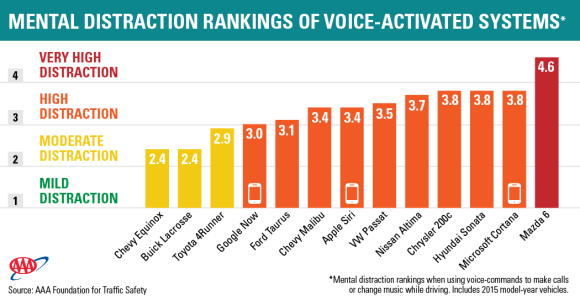

Mental distractions can persist for as long as 27 seconds after dialing, changing music or sending a text using voice commands, according to new research on distracted driving.
Drivers using phones and vehicle information systems while driving may miss stop signs, pedestrians and other vehicles while their minds are readjusting to the task of driving, according to the AAA Foundation for Traffic Safety, which says its research raises “new and unexpected concerns” regarding mental distractions.
“The lasting effects of mental distraction pose a hidden and pervasive danger that would likely come as a surprise to most drivers,” said Peter Kissinger, president and CEO of the safety group.
Researchers found that potentially unsafe levels of cognitive distraction can last for as long as 27 seconds after completing a distracting task in the worst-performing systems studied. At the 25 m.p.h. speed limit in the study, drivers traveled the length of nearly three football fields during this time. When using the least distracting systems, drivers remained impaired for more than 15 seconds after completing a task.
The research indicates that the use of voice-activated systems can be a distraction even at seemingly safe moments when there is a lull in traffic or the car is stopped at an intersection. “The reality is that mental distractions persist and can affect driver attention even after the light turns green,” Marshall Doney, president and CEO of the auto services organization, AAA.
The researchers discovered the residual effects of mental distraction while comparing new hands-free technologies in ten 2015 vehicles and three types of smart phones (Google Now, Apple Siri and Microsoft Cortana). The analysis found that all systems studied increased mental distraction to potentially unsafe levels. The systems that performed best generally had fewer errors, required less time on task and were relatively easy to use.
The researchers rated mental distraction on a five-point scale. Category one represents a mild level of distraction and category five represents the maximum. AAA considers a mental distraction rating of two and higher to be potentially dangerous.
The best performing system was the Chevy Equinox with a cognitive distraction rating of 2.4, while the worst performing system was the Mazda 6 with a cognitive distraction rating of 4.6.
Among phone systems, Google Now performed best as the least distracting with a distraction rating of 3.0, while Apple Siri and Microsoft Cortana earned ratings of 3.4 and 3.8. Using the phones to send texts significantly increased the level of mental distraction. While sending voice-activated texts, Google Now rated as a category 3.3 distraction, while Apple Siri and Microsoft Cortana rated as category 3.7 and category 4.1 distractions.
“The massive increase in voice-activated technologies in cars and phones represents a growing safety problem for drivers,” said Doney in a statement. “We are concerned that these new systems may invite driver distraction, even as overwhelming scientific evidence concludes that hands-free is not risk free.”

This latest research is in line with previous AAA Foundation reports on the dangers of verbal texting while driving and with calls by the National Transportation Safety Board to ban all phone conversations behind the wheel, even with hands-free devices.
The National Safety Council says there are dozens of studies showing that hands-free devices are no safer than handheld because the brain remains distracted by the cell phone conversation. A 2014 poll by the safety group found that 80 percent believe using hands-free phones in cars is safer than using hand-held phones, while 53 percent believe hands-free devices must be safe to use if they are built into vehicles.
A study conducted by the Virginia Tech Transportation Institute and the National Institutes of Child Health and Human Development in the New England Journal of Medicine found that teen drivers may be more at risk for distracted driving than experienced drivers.
AAA Foundation researchers say that a category 1 mental distraction is about the same as listening to the radio or an audio book. A category 2 distraction is about the same as talking on the phone, while category 3 is equivalent to sending voice-activated texts on a perfect, error-free system. Category 4 is similar to updating social media while driving, while category 5 corresponds to a highly-challenging, scientific test designed to overload a driver’s attention.
“Developers should aim to reduce mental distractions by designing systems that are no more demanding than listening to the radio or an audiobook,” said Doney. “Given that the impairing effects of distraction may last much longer than people realize, AAA advises consumers to use caution when interacting with these technologies while behind the wheel.”
Dr. David Strayer and Dr. Joel Cooper of the University of Utah conducted the AAA Foundation research. A total of 257 drivers ages 21-70 participated in the study of 2015 model-year vehicles, while 65 additional drivers ages 21-68 tested the three phone systems.
Related: